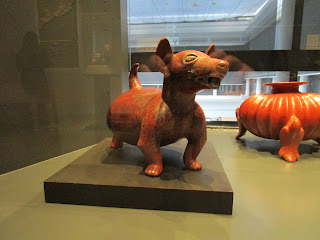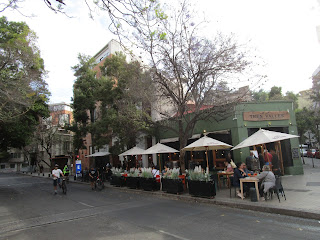 |
At Santiago's Plaza de Armas, new and old co-exist
like the religions of the world on a left-wing bumpersticker |
I knew not when this afternoon energy burst would dissipate, so I decided after climbing Cerro Santa Lucia, and it being too early for my room to be dependably ready, I decided to walk a few blocks over to the Plaza de Armas and, perhaps, take in a museum.
It's a short walk past interesting-looking buildings, only some of which I am able to attach a name. Por ejemplo, this is the Basilica de la Merced:
And before I know it, I've arrived at my destination:
There's always something happening in any Latin American city's Plaza de Armas. Por ejemplo: a man on a horse.
This is El Monumento a Pedro de Valdivia. He sits astride a horse that is transitioning from stallion to mare.
For some reason, and I hope I never find out, the horse's -- ummm -- masculine feature? -- is noticeably gone. Only some jagged white plaster where the horse's pride once was. Usually on these bronze equestrian statutes, the horse's most masculine feature has been "rubbed" to a shiny bright gold. For good luck, they always saw. Yeah, I buy that one. So, perhaps someone, at some point, was a little desperate for luck to swing his or her way and -- poof! -- the stallion transitioned to a mare. Clearly the Old Bronze Horse ain't what he used to be. But, say what you will, Pedro de Valdivia is taking it in stride. Literally.
And what do I spy here:
A map of Old Santiago! Embedded in sidewalk. Y'know, more towns could follow this example and embed old maps into sidewalks. I can't be the only map nerd tourist out there.
Which sight to see. Which site to visit next? The Catedral Metropolitana de Santiago de Chile?
El Museo Histórico Nacional? The National History Museum?
Or the Old Post Office building? CorreosChile Plaza de Armas?
CorreosChile Plaza de Armas: I will visit you tomorrow and I will visit in my capacity as one in need in postal services.
I can't find the entrance to the national museum, so it looks like Catedral Metropolitana de Santiago de Chile.
One word, however, before I enter the cathedral: power-washing.
Santiago is a very clean city. And the fact that people are out power-washing the Plaza de Armas is one of the reasons why.
The cathedral is beautiful. Not "knock my socks off' beautiful. Sock are still on. But beautiful nonetheless.
A service was going on, so I couldn't mosey around the joint playing shutterbug. But I did snap a photo of St. Michael the Archangel, looking particularly martial.
The building looks bigger on the outside:
Maybe there is a lot of territory inside that us members of the General Public cannot enter.
Speaking of not being able to enter, I entered the Tourist Information location next door to the national museum and found out why I couldn't find the entrance.
The employees of all the public museums in Santiago are on strike. The strike could last a day, It could last several months. All I know is that I will not be visiting the national museum this visit to Santiago.
The national museum is closed due to labor unrest, but if anything should be causing unrest, it would be this:
Monumento al Pueblo Indígena. Yes. Nothing says I support indigenous peoples of my native land quite like modern art. I know this is symbolic of something, in some way, but I will take a hard pass on finding out.
So, speaking of native indigenous peoples, one of the non-governmental museums I had considered visiting in Santiago was the Museo Chileno de Arte Precolombino, the Chilean Museum of Pre-Columbian Art.
In the Latin American countries I've visited so far, they refer to what we in the U.S. of A. call "pre-Columbian" as "pre-hispanic," which, come to think about it, is more descriptive. But Chilenos use the term "pre-Columbian" and I'm going local on this.
But before I go in, I'm going to walk down the street, the street being Compañía de Jesús. And, here it is: the Chilean Supreme Court:
Or, more specifically, El Palacio de los Tribunales de Justicia.
Circling back to the open museum unhampered by labor unrest:
And I spy a map, placing very indigenous peoples of the Americas in their proper geographic locales.
I am greeted by a distinctly non-Chilean statute:
This fellow is from the San Agustin region of Southern Colombia.
This one looks shockingly modern:
This I recognized as a stela from Mayan country.
This came from Southern Mexico.
And this one just looks plain grumpy:
There was a textiles area. Generally, I'm not interested in textiles, but I would like this one as a rug:
And this is a representation of a llama:
A llama on a pillow. Not normally where llamas are found. But artistic license and all that.
And this is one fat dog.
Almost Botero-esque, although the recently-deceased Fernando Botero is most definitely not "pre-Columbian."
This one looked like something drugged out from the 1960s.
Again, I like it. Again, not "pre-Columbian," if that were what this was.
This one struck me as bizarre.
It's from over 2000 years ago. Olmec, from Mexico, possibly. And yet it looks decidedly, almost stereotypically East Asian. How? How did this happen?
And while this piece doesn't traffic in Asian stereotypes, again, the style is strikingly Chinese.
Was there some sort of trans-Pacific Chinese / Indigenous American contact B.C.?
And, finally, we will end our museum tour with this:
Because, after that, what can you say?
Still not picking up on the indigenous vibe on that.
But I do want to pick up the vibe on some local cuisine:
This is the completo. Actually it is two completos. And what is a completo? A giant humongous dollop of mayonnaise, with a generic hot dog underneath. Tasted like Oscar Meyer, not something upscale like Hebrew National. But how could you taste anything under that much mayo? There are some chopped tomatoes and onions (sort of like a mildly spiced pico de gallo) nestled in the bun. The "completo" in the lower half of the picture is topped with pepper sauce. Which actually does make this delicious. With this much mayonnaise, you do not have to worry about overdoing it on the heat.
It was not nearly as mayonnaise-y as you would expect.
Room is ready.
It's a great room. Clean and quiet. Much larger than a typical hotel room anywhere else in the world other than the United States. But I'm glad I'm not staying with someone. That shower right out in the middle of the room would weird me out.
Let's take an evening stroll through Lasterria:
-

And above is the destination for my evening stroll: Emporio La Rosa. Reputedly the best ice cream in Santiago.
They did have a nice selection of flavors.
I went with a three-scoop variety pack.
One scoop of Lucumba, known in English by the unappetizing name of the "eggfruit." I'll stick with the Spanish on that one. One scoop of Naranja y Jengibre, Orange and Ginger, which was not ginger-y enough for my palate. (Truth be told: rarely is anything "ginger enough" for my taste. I love the stuff. Can't get enough.) And the white on the right side? Rosa? Yes, Rose-flavored ice cream. It's their signature flavor, being in the name of the ice cream parlor and all. It tasted like rose or, more specifically rose water. It had too much of a floral flavor to work as ice cream. The star of the cup? No doubt. The Lucumba. It was awesome. Great flavor. Creamy texture. A winner.














































No comments:
Post a Comment